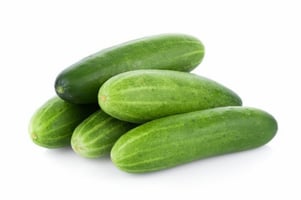An outbreak of 196 Salmonella infections across 28 states is linked through epidemiological data to...
Hold the Onions - Another Outbreak Linked to Fresh Onions
 On October 22, 2024, FDA and CDC notified the public of an outbreak involving E. coli O157:H7 associated with burgers from a major fast food chain. Currently, 75 illnesses, 22 hospitalizations, and 1 death over 13 states have been reported. Initial traceback and distribution information reviewed by FDA indicates that slivered onions served on quarter pound burgers are a likely source of contamination. A manufacturer that distributes to food service facilities has been reported as the source of the slivered onions, resulting in other fast food chains removing fresh onions from their menus. Onions present a food safety hazard and although they have not been involved in recent outbreaks involving E. coli O157:H7, they have been implicated in several outbreaks involving another enteric pathogen, Salmonella. As recently as last year, fresh diced onions caused an outbreak of Salmonella Thompson infections that resulted in 80 illnesses, 18 hospitalizations, and 1 death. Diced yellow and red onions, diced onions and celery, and a diced mixed vegetable product were recalled after being distributed to stores, restaurants, and institutions in the U.S. and Canada. FDA’s investigation found the outbreak strain in water and environmental samples collected from the farm that supplied the contaminated onions to the diced onion manufacturer.
On October 22, 2024, FDA and CDC notified the public of an outbreak involving E. coli O157:H7 associated with burgers from a major fast food chain. Currently, 75 illnesses, 22 hospitalizations, and 1 death over 13 states have been reported. Initial traceback and distribution information reviewed by FDA indicates that slivered onions served on quarter pound burgers are a likely source of contamination. A manufacturer that distributes to food service facilities has been reported as the source of the slivered onions, resulting in other fast food chains removing fresh onions from their menus. Onions present a food safety hazard and although they have not been involved in recent outbreaks involving E. coli O157:H7, they have been implicated in several outbreaks involving another enteric pathogen, Salmonella. As recently as last year, fresh diced onions caused an outbreak of Salmonella Thompson infections that resulted in 80 illnesses, 18 hospitalizations, and 1 death. Diced yellow and red onions, diced onions and celery, and a diced mixed vegetable product were recalled after being distributed to stores, restaurants, and institutions in the U.S. and Canada. FDA’s investigation found the outbreak strain in water and environmental samples collected from the farm that supplied the contaminated onions to the diced onion manufacturer.
In 2021, an outbreak involving Salmonella Oranienburg contaminated onions caused 1040 illnesses and 260 hospitalizations nationwide. Red, yellow, and white whole, fresh onions imported from the State of Chihuahua, Mexico were recalled. As a result of this outbreak, the FDA initiated onsite domestic investigations as well as Foreign Supplier Verification Program (FSVP) inspections of domestic firms who imported onions from the State of Chihuahua, Mexico to determine if they were in compliance with applicable FSVP requirements, including performing certain risk-based activities to verify that imported foods meet U.S. safety standards.
In 2020, an outbreak involving Salmonella Newport contaminated red onions caused more than 1600 illnesses in the U.S. and Canada, and 116 hospitalizations in the U.S. FDA investigated the outbreak and in May 2021 released the 2020 Salmonella Outbreak Linked to Red Onions Report. The epidemiological investigation linked Salmonella Newport illnesses to red onions grown in the Southern San Joaquin Valley and Imperial Valley in California. The subsequent onsite FDA inspection of the growing region and packing facility led to the sampling of 1100 onion products and 800 environmental samples (including animal scat,
agricultural water, environmental swabs of food contact and non-food contact surfaces, soil samples, and sediment samples). Of these samples, none that were positive could be linked with Whole Genome Sequencing (WGS) to the S. Newport outbreak strain. However, 10 water samples and 1 sediment sample collected near one of the growing fields were positive for Salmonella Newport, representing a total of three different genotypical strains (unique WGS patterns).
Testing results could not identify a conclusive root cause; however several potential contributing factors were identified. Environmental contamination could have occurred from the numerous birds, ground squirrels, and bird scat that were observed around the growing fields and equipment as well as sheep grazing in adjacent fields. Salmonella strains were found in irrigation canal water samples and the drainage network samples that also found serotype Newport. The packing house did not have adequate measures in place to exclude pests, indicated by signs of animal and pest intrusion. Also, food contact surfaces had not been inspected, maintained, cleaned, or sanitized as frequently as necessary to protect against the contamination of produce.
The leading hypothesis indicated that contaminated irrigation water may have led to contamination of the onions. The cross-connection of irrigation canals and field drainage networks could serve as a route of broader contamination, especially since irrigation water used to grow onions is not customarily treated before application to fields. Processing could lead to further contamination spread. FDA suggested growers conduct risk assessments that include evaluation of hazards that may be associated with adjacent and nearby land uses and apply appropriate science- and risk-based preventive measures, including applicable provisions of the FDA Food Safety Modernization Act Produce Safety Rule and good agricultural practices.
As a result of the 2020 and 2021 onion outbreaks, the FDA formulated preventive strategies to enhance the food safety of onions as part of their Foodborne Outbreak Response Improvement Plan. A root cause analysis approach was used when examining the findings of the outbreak investigations to uncover potential sources, routes of contamination, and preventive measures that could be used to reduce the incidence of future foodborne illness.

.jpg?height=200&name=shutterstock_1196554828%20(1).jpg)
